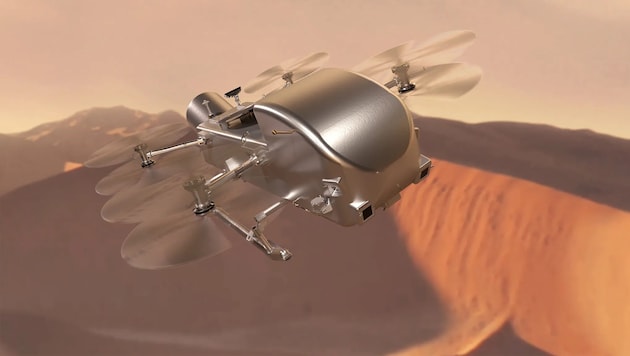Launch planned for 2028
NASA wants to explore Saturn’s moon Titan with a drone
The US space agency NASA wants to explore Saturn's moon Titan with a drone. The "Dragonfly" mission is scheduled to launch in 2026 and reach Saturn's largest satellite in 2034, as NASA recently announced.
The "Dragonfly" mission to Saturn's largest moon, which has already been postponed several times, is expected to start in July 2028. The drone, which is the size of a car and is being built by the Johns Hopkins Applied Physics Laboratory (APL) in Laurel, Maryland, is expected to reach the moon Titan in 2034. This will be the first time that a scientific vehicle will "fly on another planetary body (i.e. the moon)", according to the NASA website.
Over the next two and a half years, the nuclear-powered aircraft, which has eight rotors, will take off on an exploratory flight every Titan day - 16 days for us Earthlings - and search dozens of pre-selected locations for prebiotic chemical processes that occur on both Titan and the early Earth before the emergence of life.
Inhospitable minus 180 degrees on the surface
However, Titan is not all that life-friendly. The moon consists largely of ice and has average temperatures of around 180 degrees below freezing due to its great distance from the sun - it is ten times further away than our Earth. Because of its nitrogen-rich and dense atmosphere and the presence of liquid, Titan is considered one of the most Earth-like celestial bodies in the solar system.
What is Titan?
With a diameter of 5150 kilometers, Titan is the largest of the 146 moons of the planet Saturn known to date, which is why it was named after the Titan family of gods. The icy satellite is the second largest moon in our solar system after Jupiter's moon Ganymede and the only one with a dense gaseous envelope. It was discovered in 1655 by the Dutch astronomer Christiaan Huygens.
Lakes of methane discovered on Titan
NASA and its European counterpart ESA gathered important preliminary knowledge for the planned "Dragonfly" mission through the "Cassini-Huygens" space mission launched in 1997. Two coupled probes - "Cassini" and "Huygens" - were sent to Saturn. The former examined Saturn from orbit, while the latter landed on Titan, where it discovered, among other things, lakes of methane, which are thought to contain a variety of organic compounds.











Da dieser Artikel älter als 18 Monate ist, ist zum jetzigen Zeitpunkt kein Kommentieren mehr möglich.
Wir laden Sie ein, bei einer aktuelleren themenrelevanten Story mitzudiskutieren: Themenübersicht.
Bei Fragen können Sie sich gern an das Community-Team per Mail an forum@krone.at wenden.